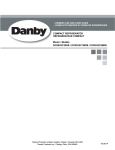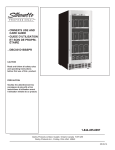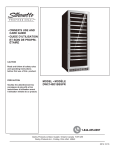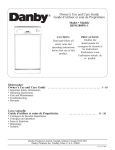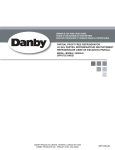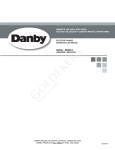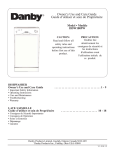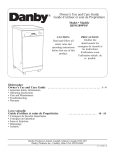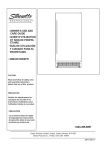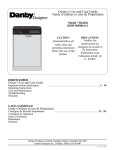Download Danby DDW1809 User's Manual
Transcript
Owner’s Use and Care Guide Guide d’utiliser et soin de Propriétaire Model • Modèle DDW1809W-1 CAUTION: Read and follow all safety rules and operating instructions before first use of this product. PRECAUTION: Veuillez lire attentivement les consignes de sécurité et les instructions d'utilisation avant l'utilisation initiale de ce produit. Dishwasher Owner’s Use and Care Guide . . . . . . . . . . . . . . . . . . . . . . . . . . . . . . . . . . . . . . . 1 - 10 • Important Safety Information • Operating Instructions • Care and Maintenance • Troubleshooting • Warranty Lave-vaisselle Guide d’utiliser et soins de Propriétaire • Consignes de Sécurité Importantes . . . . . . . . . . . . . . . . . . . . . 11 - 20 • Consignes d’opération • Soins et Entretien • Dépannage • Garantie Danby Products Limited, Guelph, Ontario Canada N1H 6Z9 Danby Products Inc. Findlay, Ohio, U.S.A .45840 08.10.14 1-800-263-2629 (1-800-26-DANBY) DO NOT RETURN THIS UNIT TO THE RETAILER WITHOUT FURTHER INSTRUCTIONS Dear valued customer, we hope your Danby product purchase fulfills all your requirements. Your satisfaction is our priority! Please contact us at our toll free consumer service number for any inquiries you may have about your new unit. NE PAS RETOURNER CET APPAREIL CHEZ LE DÉTAILLANT SANS CONSIGNES SUPPLÉMENTAIRES Cher(ère) client(e) important(e), nous espérons que votre produit Danby répond à tous vos besoins. Votre satisfaction est notre priorité! Veuillez nous contacter au numéro gratuit de service après-vente, si vous avez des questions quelconques à propos de votre nouvel appareil. NO DEVUELVA ESTA UNIDAD A LA TIENDA SIN INSTRUCCIONES ADICIONALES Estimado cliente, esperamos que el producto Danby que ha comprado satisfaga completamente sus necesidades. Su satisfacción es nuestra prioridad! Por favor, contáctenos gratuitamente a nuestro número de Servicio al Cliente para cualquier pregunta que tenga sobre su nuevo electrodoméstico. Danby 28.08.2014 IMPORTANT SAFETY INSTRUCTIONS WARNING: When loading your dishwasher, follow basic safety precautions, including the following: • Read all instructions before using the dishwasher. • Use the dishwasher only for its intended function (normal, household use only). • Use only detergents or wetting agents recommended for use in a dishwasher; do not use them for handwashing, and keep them out of the reach of children. When loading items to be washed: • Locate sharp items (e.g. forks or knives) so that they are not likely to damage the door seal. • Load sharp knives with the handles up to reduce the risk of cut-type injuries. • Do not wash plastic items unless they are marked “dishwasher safe” or the equivalent. For plastic items not so marked, check the manufacturer’s recommendations. • Do not touch the heating element during or immediately after use. • Do not operate the dishwasher unless all enclosure panels are properly in place. • Do not tamper with the controls. • Do not abuse, sit on, or stand on the door or dish-rack of the dishwasher. • To reduce the risk of injury, do not allow children to operate (or play in or on) the dishwasher. • Do not allow children to play around the dishwasher when opening or closing the dishwasher door. • Remove the door to the washing compartment when removing an old dishwasher from service or discarding it. • Do not spray water on the appliance (it may cause electric shock or failure of electrical parts). DANGER! • DISHWASHER DETERGENT IS A STRONG ALKALINE AND CAN BE EXTREMELY DANGEROUS IF SWALLOWED; AVOID CONTACT WITH SKIN AND EYES, AND KEEP CHILDREN AWAY FROM THE DISHWASHER WHEN THE DOOR IS OPEN. CHECK THAT THE DETERGENT RECEPTACLE IS EMPTY AT THE END OF EACH WASH CYCLE. • WARNING! HYDROGEN GAS IS EXPLOSIVE Under certain conditions, hydrogen gas may be produced in a hot-water system that has not been used for two weeks or more. HYDROGEN GAS IS EXPLOSIVE. If the hot-water system has not been used for such a period, before using the dishwasher turn on all hot-water faucets and let the water flow from each for several minutes. This will release any accumulated hydrogen gas. As the gas is flammable, do not smoke or use an open flame during this time. ELECTRICAL INSTRUCTIONS An electrical supply of 120V AC only, 60 Hz is required. For your personal safety, the appliance must be grounded. To minimize possible shock hazards it must be plugged into a matching 3-prong (grounding type) electrical outlet. If the power cord is damaged, it must be replaced by the manufacturer or service agent, or a similarly qualified person in order to reduce the risk of a hazard. 1 IMPORTANT SAFETY INSTRUCTIONS (cont’d) SAVE THESE INSTRUCTIONS! SAFETY PRECAUTIONS • Do not abuse, sit or stand on the door or dishrack of the dishwasher. • Do not touch the heating element during or immediately after use. • Do not wash plastic items unless they are marked dishwasher safe. For unmarked plastic items, check the manufacturer's recommendations. • Use only detergent and rinse additives designed for an automatic dishwasher. Never use laundry detergent, or hand washing detergent in your dishwasher. Keep these products out of the reach of children. • Keep children away from the detergent and rinse aid, and from the open door of the dishwasher, as there could still be some detergent left inside. • The door should not be left in the open position as this could present a tripping hazard. • During installation, the power supply must not be excessively or dangerously bent or flattened. • To reduce the risk of injury, do not allow children to play in or on a dishwasher. • Do not operate your dishwasher unless all enclosure panels are properly in place. Open the door very carefully if the dishwasher is operating, there is a risk of water spraying out. • Do not place any heavy objects on the door when it is open. The appliance could tip forward. When loading items to be washed: 1) Load sharp items so that they are not likely to damage the door seal. 2) Load sharp knives with the handles up to reduce the risk of cuts. • When using your dishwasher, you should prevent plastic items from coming in contact with the heating element. • Please dispose of packing materials properly. • Use the dishwasher only for its intended function. • Remove the door to the washing compartment when removing an old dishwasher from service or discarding it. 2 OPERATING INSTRUCTIONS 3 1 11 9 4 2 10 6 8 5 7 1) Pre-Rinse Light: Illuminates during Pre-Rinse Cycle. 2) Wash Light: Illuminates during Wash Cycle. 3) Rinse Light: Illuminates during Rinse Cycle. 4) Drying Light: Illuminates during Drying period. 5) Door Handle: Pull to open the door. 6) START/PAUSE Button: Press this button to start or pause dishwasher; light will illuminate when starting. 7)Wash Program Selector: Turn the knob clockwise to select wash cycles. 8) ON/OFF Button: To turn on/off the power supply. Note: This model has a “Program Memory” function; Cutton off power supply during washing will not reset the current wash program. To cancel a program see “Cancelling or Modifying a Wash Cycle Setting” pg. 7. 9) Power Light: Illuminates when ON/OFF button is pressed. 10) Salt Aid Warning Light: Illuminates when softener dispenser needs refilling. 11) Rinse Aid Warning Light: Illuminates when rinse aid dispenser needs refilling. WASH CYCLES Cycle Name Type INTENSIVE Intensive Wash NORMAL Normal wash ECONOMY Light Wash Description Detergent (pre/main) 4/20 gr. For heavily soiled loads, such as pots, pans, casserole dishes and dishes with dried food. For normally soiled loads, such as pots, plates, glasses, bowls, and lightly soiled pans. Standard daily cycle. For lightly soiled loads, such as plates, glasses, bowls and lightly soiled pans. 4/20 gr. 20 gr. RINSE Rinse For dishes that need to be rinsed and dried only. RAPID WASH Glassware For lightly soiled loads, such as glasses, crystal and fine china. 15 gr. SOAK Soak Use to rinse the dishes that you plan to wash later that day. 15 gr. 3 OPERATING INSTRUCTIONS (cont’d) WATER SOFTENER There are two ways to reduce the water hardness: one way is by using water softener, the other is by using detergent. The hardness of the water varies from place to place. If hard water is used in the dishwasher, deposits will form on the dishes and utensils. The appliance is equipped with a special softener that uses salt specifically designed to eliminate lime and minerals from the water. LOADING THE Always use salt intended for use with dishwashers. SALT INTO The salt container is located beneath the lower rack and should be filled as THE follows: SOFTENER 1. Remove the lower basket and unscrew and remove the cap from the salt container. 2. If you are filling the container for the first time , fill 2/3 of its volume with water. 3. Place the end of the salt filter(supplied) into the hole and introduce about 2kg of salt . It is normal for a small amount of water to come out of the salt container. 4. Carefully screw on the cap. NOTE 1. The salt container must be refilled when the salt warning light comes on. Though the salt container is filled, the indicator light may not black out before the salt fully dissolves. 2. If there are spills of salt, a soak program could be run to clean the spills. The dishwasher is designed to allow for adjusting the amount of salt consumed ADJUSTING based on the hardness of the water used. This is intended to optimize and SALT CONSUMPTION customize the level of salt consumption. 1. Unscrew the cap from the salt container. 2. There is a ring on the container with an arrow on it (see Figure to the side). If necessary, rotate the ring in the counterclockwise direction from the "-" setting toward the "+" sign, based on the hardness of the water being used.It is recommended that adjustments should be made in accordance with the following chart: WATER HARDNESS Selector Position Salt consumption (gram/cycle) Auto nomy (cycles/2kgs) 0~1.7 - 0 / 18~44 1.8~4.4 / 20 60 45~89 4.5~8.9 MED 40 40 8.9 + 60 25 Clarke Degrees dH mmol/l 0~14 0~10 14~36 36~71 71 89 Contact your local water board for information on the hardness of your water supply. 4 OPERATING INSTRUCTIONS (cont’d) DETERGENT DISPENSER WARNING: Dishwasher detergent is corrosive! Take care to keep out of the reach of children. 2 4 The dispenser must be refilled before the start of each wash cycle according to the measurements provided in the “Wash Cycles” table on the previous page. Your dishwasher uses less detergent and rinse aid than conventional dishwashers. Generally, only one tablespoon of detergent is needed for a 1 normal wash load. More heavily soiled items need more detergent. Always add the detergent just before starting dishwasher, otherwise it could become damp and not dissolve properly. Amount of Detergent to Use: If your water is not too hard, you may also prevent the formation of deposits by adding detergent. The amount of detergent needed can vary due to differences in water hardness. To determine the water hardness in your area, contact your local water utility or area water softening company. The harder your water, the more detergent you may need. • Use only detergent specifically made for use in dishwashers. Keep your detergent fresh and dry. Don’t put powder detergent into the dispenser until you are ready to wash dishes. Removing Hard Water Spots From Dishes- Try the following: • Run dishes through a normal wash program. • Remove all metal dishware, such as cutlery, pans etc. from dishwasher. • Do not add detergent. • Pour 2 cups of vinegar into a bowl, set it face up on lower rack of dishwasher and run dishes through normal wash program. 5 6 1) Main Wash Detergent 2) Dispenser Lid Lever 3) Prewash Detergent Compartment 4) Rinse Aid Level Indicator 5) Rinse Aid Compartment 6) Detergent Compartment Lid RINSE AID DISPENSER • To open the dispenser, turn the cap to the “open” (left arrow) position and lift out. • Pour the rinse aid into the dispenser, being careful not to overfill. • Replace the cap by inserting it aligned with “open” arrow and turning it to the “closed” (right arrow) position. The rinse aid is released during the final rinse to prevent water from forming droplets on your dishes that can leave spots and streaks. It also improves drying by allowing water to "sheet" off the dishes. • Your dishwasher is designed to use liquid rinse aids. The rinse aid dispenser is located inside the door next to the detergent dispenser. To fill the dispenser, open the cap and pour the rinse aid into the dispenser until the level indicator turns completely black. The dispenser holds about 3.5 oz of liquid rinse aid. • Be careful not to overfill the dispenser, because this could cause over sudsing. Wipe away any spills with a damp cloth. Don't forget to replace the cap before you close the dishwasher door.If you have soft water, you may not need rinse aid as it may cause a white film to develop on your dishes. A measured amount of rinse aid is released during the final rinse. As with detergent, the amount of rinse aid needed for your dishes depends on the hardness of the water in your area. Too much rinse aid can result in lather or foaming and can cause cloudiness or streaks on your dishes. If the water in your area is very soft, you may not need rinse aid. If you do, you can dilutethe rinse aid with an equal amount of water. The rinse aid dispenser has 4 settings. Always start with the dispenser set on " 1 ". If spots and poor drying are problems, increase the amount of rinse aid dispensed by removing the dispenser lid and rotating the dial to "2". If the dishes still are not drying properly or are spotted, adjust the dial to the next higher number until your dishes are spot-free. We suggest the setting of "3". When to Refill the Rinse Aid Dispenser: If there is no rinse aid warning light on the control panel, you can judge the amount of rinse aid by the following means. The black dot on the rinse aid dispenser indicates the amount of rinse aid in the dispenser. As the rinse aid diminishes, the size of the black dot decreases. You should never let the rinse aid get below 1 / 4 full. As the rinse aid diminishes, the size of the black dot on the rinse aid level indicator changes: 5 Full 3/4 Full 1/2 Full 1/4 full (Refill) Empty 3 OPERATING INSTRUCTIONS (cont’d) LOADING For best performance, follow these loading guidelines. DISHWASHER Features and appearance of racks and silverware baskets RACKS may vary from your model. HOW TO USE THE UPPER RACK: The upper rack is designed to hold more delicate and lighter dishware such as glasses, coffee and tea cup and saucers, as well as plates, small bowls and lightly soiled shallow pans. Position the dishes and cookware so that they do not get moved by the spray of water. The upper rack can be adjusted for height by putting wheels of different height into the rails. 4 HOW TO USE THE LOWER RACK: We recommend that you place large 6 5 items in the lower rack: pots, pans, lids, serving dishes and bowls, as shown below. It is preferable to place serving dishes and lids on the side of the racks 7 in order to avoid blocking the rotation of the top spray arm. Pots, serving 9 8 bowls, etc, must always be placed top down. Deep pots should be slanted to allow water flow. The bottom rack features fold down tine rows so that larger or more pots and pans can be 4) Serving b owl loaded. 5) b owl 6) Small plates 7) Serving p late 8) Large plates 9) Silverware basket 4 3 1 3 2 1) Cups 2) Saucer 3) Glasses SILVERWARE BASKET Silverware should be placed in the silverware basket with handles at the bottom: If the rack has side baskets, the spoon should be loaded individually in the appropriate slots. Long utensils should be placed in the horizontal position at the front of the upper rack. WARNING: Do not let any item 1) Salad Forks 2 4 5 1 extend beyond the bottom of the 4 5 1 basket. 2) Teaspoons 2 4 5 1 3) Soup s poons 2 4 5 1 4) Dinner f orks 4 5 1 5) Knife 2 4 5 4 6) Serving s poon 2 4 5 7 7) Serving f ork 3 5 2 3 3 1 2 2 3 3 3 3 3 6 1 1 6 6 OPERATING INSTRUCTIONS (cont’d) TURNING ON THE APPLIANCE Starting a wash cycle. . . 1) Make sure that the plug for the appliance is inserted into the wall socket. 2) Make sure that the water supply is turned on to full pressure. 3) Load the dishwasher (see "Loading Dishwasher Racks"on previous page). 4) Pour in the detergent (see "Detergent Dispenser" on page 3). 5) Turn the dial located on the right of the control panel in the clockwise direction until the number or the symbol for the cycle setting is aligned with the reference mark (see "Wash Cycles" on page 2). 6) Press the ON/ OFF button, and the ON/OFF light will turn on. At this point, the wash cycle will begin. Cancelling or Modifying a Wash Cycle Setting... A cycle that is underway can only be modified if it has only been running for a short time. Otherwise, the detergent may have already been released, and the appliance may have already drained the wash water. If this is the case, the detergent dispenser must be refilled (see “Detergent Dispenser” on page 3). Press the ON/OFF button, and the ON light will turn off. Rotate the dial in the clockwise direction to the desired cycle setting (see " Starting a wash cycle. . . " above). Then, turn the dishwasher back on using the ON/OFF button. Forgot to Add a Dish? A forgotten dish can be added any time before the detergent cup opens. 1) Pull the door handle. 2) Do not open the door until the water spray action stops. Steam may rise out of the dishwasher. 3) Add forgotten dish(es). 4) Push the door closed. Press "START" to begin. FILTERING SYSTEM 1) MAIN FILTER: Food and soil particles trapped by this filter are pulverized by a special jet on the lower spray arm and washed down the drain. 2) COARSE FILTER: Larger items, such as pieces of bone or glass, that could clog the drain are trapped in the coarse filter. To remove an item caught in this filter, gently squeeze the tabs on top of this filter and lift it out. 3) FINE FILTER: This filter holds soil and food residue in the sump area and prevents it from being redeposited on the dishes during a cycle. FEATURES 1) Upper Rack 2) Spray Arms 3) Lower Rack 4) Water Softener 5) Main Filter 6) Detergent Dispenser 7) Cup Shelf 8) Silverware Basket 9) Coarse Filter 10) Rinse Aid Dispenser 11) Drain Hose 12) Inlet Valve 13) Junction Box 14) Leveling Leg 7 CARE AND MAINTENANCE CLEANING: To clean the control panel use a lightly dampened cloth then dry thoroughly. To clean the exterior use a good appliance polish wax. Never use sharp objects, scouring pads or harsh cleaners on any part of the dishwasher. PROTECT AGAINST FREEZING: If your dishwasher is left in an unheated place during the winter, ask a service technician to: 1) Cut off electrical power to the dishwasherand remove fuses or trip circuit breaker. 2) Turn off the water supply and disconnect the water inlet pipe from the water valve. 3) Drain the water from the inlet pipe and water valve (use a pan to catch the water). 4) Reconnect the water inlet pipe to the water valve. 5) Remove the plastic sump cover in the tub the bottom and use a sponge to soak up the water in rubber boot. CLEANING THE SPRAY ARMS: It is necessary to clean the spray arms regularly as hard water chemicals will clog the spray arm jets and bearings. To remove the spray arm, screw off the nut to take out the washer on top of the spray arm and remove the arm. Wash the arms in soapy, warm water and use a soft brush to clean the jets. Replace after rinsing them thoroughly. CLEANING THE FILTERS: • For best performance and results, the filter assembly must be cleaned. • Inspect the filters for obstructions every time the dishwasher has been used. • By unscrewing the coarse filter you can remove the filter system. Remove any food remnants and use a cleaning brush to clean the filters under running water. • Follow Step 1 to Step 3 to remove the filter system; follow Step 3 to Step 1 to install the filter system. WARNING: NEVER RUN THE DISHWASHER WITHOUT THE FILTERS IN PLACE. CLEANING THE DOOR: To clean the edge around the door, you should use only a soft warm, damp rag. To prevent penetration of water into the door lock and electrical components, do not use a spray cleaner of any kind. Also, never use abrasive cleaners or scouring pads on the outer surfaces because they will scratch the finish. Some papers towels can also scratch or leave marks on the surface. How to Keep Your Dishwasher Running Properly... After Every Wash- After every wash, turn off the water supply to the applianceand leave the door slightly ajar so that moisture and odors are not trapped inside. No Solvents or Abrasive Cleaning Products- To clean the exterior and rubber parts of the dishwasher, do not use solvents or abrasive cleaning products. Use only a cloth and warm, soapy water. To remove spots or stains from the surface of the interior, use a cloth dampened with warm water and a little white vinegar, or a cleaning product made specifically for dishwashers. When You Go on Holiday- When you go on holiday, it is recommended that you run a wash cycle with the dishwasher empty and then remove the plug from the socket, turn off the water supply and leave the door of the appliance slightly ajar. This will help the seals last longer and prevent odors from forming in the appliance. Seals- One of the factors that cause odors to form in the dishwasher is food that remains trapped in the seals. Periodic cleaning with a damp sponge will prevent this from occurring. 8 TROUBLESHOOTING PROBLEM 1) Dishwasher doesn’t run POSSIBLE CAUSE • Fuse blown or circuit breaker tripped. • Replace fuse or reset circuit breaker. • Power supply is not turned on. • Make sure dishwasher is turned on and door is closed. Plug in cord securely. • Water pressure is low. • Check that water supply is connected and the water is turned on. 2) Drain pump doesn’t stop • Overflow 3) Noise • Some audible sounds are normal. • Utensils are not secure in basket / something small dropped into basket. • Motor hums. 4) Suds in the tub • Improper detergent. • Spilled rinse agent. 5) Dishes are not dry 6) Dishes and flatware are not clean (spots / filming) • Rinse agent dispenser is empty. • Improper program selected/run. • Improper rack loading. • Extremely hard water. 7) Detergent left in • Dishes blocking detergent cups. dispenser cups 8) Water standing • This is normal. in the bottom of the tub 9) Water doesn’t pump out of the tub 10) Dishwasher leaks / steams SOLUTION • The system is designed to detect an overflow. When it does, it shuts off the circulation pump and turns on the drain pump. • Sound from soft food shredding action and detergent cup opening. • Ensure everything is secured in the dishwasher. • If you do not use often, dishwasher may hum- remember to fill and pump out appliance every week to keep the seal moist. • Use only dishwasher detergent to avoid suds. If suds are present, open the door and let suds evaporate. • Always wipe rinse agent spills immediately. • Make sure that the rinse agent dispener is filled. • Select a stronger program. • Make sure that the detergent dispenser and spray arms are not blocked by large dishware. • Remove all metal utensils from dishwasher. See “Removing Hard Water Spots from Dishes” pg 3. • Re-load the dishes properly. • A small amount of clean water around the outlet on the tub button at the back of the tub keeps the water seal lubricated. • Drain is clogged. • Make sure the kitchen sink is draining well. If the dishwasher drains into a disposer, run it clear. • Overfill dispenser or rinse aid spills. • Be careful not to overfill the rinse aid • Dishwasher isn’t level. dispenser. Spilled rinse aid could cause • Steam is normal. oversudsing and lead to overflowing. Wipe away any spills with a damp cloth. • Make sure the dishwasher is level. • Steam coming through the vent by the door latch is normal during drying and water draining. 9 LIMITED IN-HOME APPLIANCE WARRANTY LIMITED IN-HOME APPLIANCE WARRANTY This quality product is warranted to be free from manufacturer’s defects in material and workmanship, provided that the unit is used under the normal operating This quality product warranted to be free from manufacturer’s defects in material and workmanship, provided that the unit is conditions intended by theismanufacturer. used under the normal operating conditions intended by the manufacturer. This warranty is available only to the person to whom the unit was originally sold by Danby Products Limited (Canada) or Danby Products Inc. (U.S.A.) (hereafter This warranty is available only to the person to whom the unit was originally sold by Danby Products Limited (Canada) or “Danby”) or by an authorized distributor of Danby, and is non-transferable. Danby Products Inc. (U.S.A.) (hereafter “Danby”) or by an authorized distributor of Danby, and is non-transferable. TERMS OF WARRANTY TERMS OF WARRANTY Plastic parts, are warranted for thirty (30) days only from purchase date, with no extensions provided. Plastic parts, are warranted for thirty (30) days only from purchase date, with no extensions provided. First year First Year To obtain service To obtain Service During the first twelve (12) months, any functional parts of this product found to be defective, will be repaired replaced, at any warrantor’s option, at no charge the ORIGINAL purchaser. During the first or twelve (12) months, functional parts of this product found to betodefective, will be repaired or replaced, option, at no charge to the ORIGINAL purchaser. at warrantor’s Danby reserves the right to limit the boundaries of “In Home Service” to the proximity of an Authorized Service Depot. Any appliance requiring service outside the limited boundaries of “In Home Service” ,it Danby reserves the right to limit the boundaries of “In Home Service” to the proximity of an Authorized Service Depot. Any app liance will be the consumer’s responsibility to transport the appliance (at their own expense) to the original requiring service outside the limited boundaries of “In Home Service” , it will be the consumer’s responsibility to transport the appliance (at retailer (point of purchase) or a service depot for repair. See “Boundaries of In Home Service” below. their own expense) to the original retailer (point of purchase) or a service depot for repair. See “Boundaries of In Home Serv ice” below. Contact your dealer from whom your unit was purchased, or contact your nearest authorized Danby Contact your dealer from whom your unit was purchased, or contact your nearest authorized Danby service depot, where service service depot, where service must be performed by a qualified service technician. If service is performed must be performed by a qualified service technician. on the units by anyone other than an authorized service depot, or the unit is used for commercial If service is performed the units by anyone other than an authorized service depot, the unit is used for commercial appli cation, all application, allonobligations of Danby under this warranty shallor be void. obligations of Danby under this warranty shall be void. Boundaries of Boundariesservice of in-home In Home Service If the appliance is installed in a location that is 100 kilometers (62 miles) or more from the nearest If the appliancecenter is installed in aunit location that be is 100delivered kilometers (62 or more from the nearest service center your unitDepot, must be service your must to miles) the nearest authorized Danby Service as service delivered the nearest authorized Danby Depot, asqualified service must onlycertified be performed a technicianservice qualified by and Danby. certif Transporied for musttoonly be performed by a Service technician and forby warranty warranty by Danby. Transportation charges to andlocation from the service location are not protected this warrantyand and are are t the responsihe tationservice charges to and from the service are not protected by thisbywarranty responsibility of thepurchaser. purchaser. bility of the Nothing within thisthis warranty shall imply that imply Danby will be Danby responsiblewill or liable for any spoilageor or damage or other c ontents of this appliance, due Nothing within warranty shall that be responsible liable to forfood any spoilage or damage to food whether or other to any defect the appliance, or itswhether use, whetherdue proper improper. contents of ofthis appliance, to or any defect of the appliance, or its use, whether proper or improper. EXCLUSIONS EXCLUSIONS Save herein provided, by Danby, there are no other representations warranties, or conditions, representations Save asasherein provided, Danby, there are no other warranties, conditions, guarantees, express or implied, m or guarantees, ade or intendedexpress by Danby or or its implied, or intended Danbyconditions, or its authorized distributors all other warranties, representations or authorizedmade distributors and all otherby warranties, representations or guarantees,and including any warranties, conditioconditions, ns, representations or guarantees guarantees, including any conditions, representations guarantees undershall any Act or legislation under any Sale of Goods Act or likewarranties, legislation or statue is hereby expressly excluded. Saveor as herein provided, Danby no Sale of tGoods be responsible for like any damages ortostatute herebyincluding expressly Save as herein provided,damages Danbyarising shallfrom notthebe responsible for to persons persons orisproperty, the unitexcluded. itself, howsoever caused or any consequential malfunction o f theany unitdamages and by the purchase of orthe property, including unit itself, howsoever or any consequential damages arising from they caused malfunction of the unit unit, the purchaser doesthe hereby agree to indemnify and holdcaused harmless Danby from any claim for damages to persons or propert by the unit. and by the purchase of the unit, the purchaser does hereby agree to indemnify and hold harmless Danby from any claim for damages to persons or property caused by the unit. GENERAL PROVISIONS No warranty or insurance herein contained or set out shall apply when damage or repair is caused by any of the following: GENERAL PROVISIONS 1) Power failure. No warranty or insurance herein contained or set out shall apply when damage or repair is caused by any of the following: 1) Power failure.in transit or when moving the appliance. 2) Damage 2) Damage in transit when the defective appliance. 3) Improper poweror supply suchmoving as low voltage, house wiring or inadequate fuses. 3) Improper power supply such as low voltage, defective house wiring or inadequate fuses. 4) Accident, alteration, abuse or misuse of the appliance such as inadequate air circulation in the room or abnormal operating con ditions 4) Accident, alteration, abuse or misuse of the appliance such as inadequate air circulation in the room or abnormal operating (extremely high or low room temperature). conditions (extremely high or low room temperature). for commercialor or industrial purposes (ie. If the(ie. appliance not installed inisa domestic residence). 5) Use5)forUse commercial industrial purposes If theisappliance not installed in a domestic residence). 6) Fire, water damage, theft, war, riot, hostility, acts of God such as hurricanes, floods etc. 6) Fire, water damage, theft, war, riot, hostility, acts of God such as hurricanes, floods etc. 7) Service callscalls resulting customer education. 7) Service resulting inincustomer education. 8) Improper Installation Building-in of astanding free standing or using anthat appliance outdoors is not approved for 8) Improper Installation(ie. (ie. Building-in of a free appliance orappliance using an appliance outdoors is not approved for out that door application). outdoor application). Proof of for purchase dateso, will be retain required so, please retain billspresent of sale. In the event Proof of purchase date will be required warranty claims; please bills offor sale.warranty In the eventclaims; warranty service is required, this document to our warranty service required, present this document to our AUTHORIZED SERVICE DEPOT. AUTHORIZED SERVICEisDEPOT. WarrantyService Service Warranty In-home In























